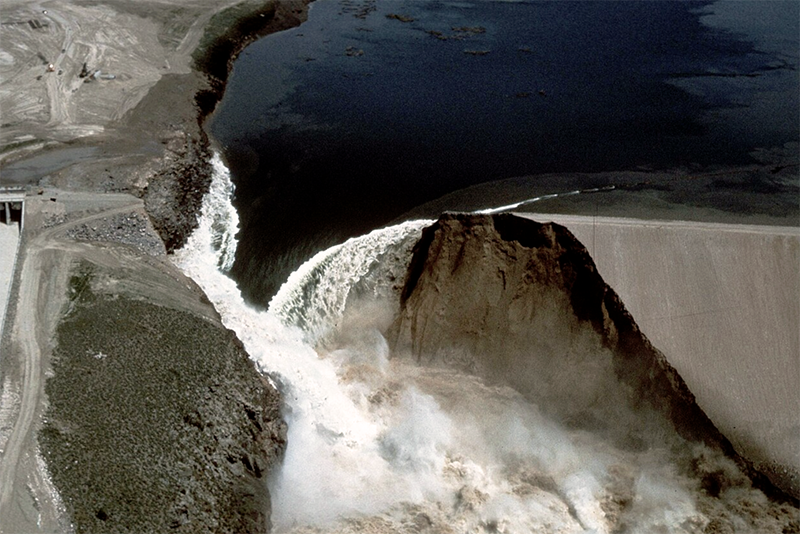|
Teton dam failure, June 5, 1976, Teton Canyon, Idaho. IS DISPERSION IMPORTANT IN FLOOD ROUTING?
Professor Emeritus of Civil and Environmental Engineering
San Diego State University, San Diego,
California
1. INTRODUCTION
Flood routing is the calculation of the movement
of a flood wave in space and time along a stream or channel.
The governing equations are the equations of
water continuity and motion of open-channel flow, the so-called
Saint-Venant
The realization that the role of inertia is very often minimal led
Hayami (1951) to
simplify the flood routing problem by combining the set of two governing equations into
one equation, with space x and time t
as independent variables and discharge Q as the dependent variable. This equation is
referred to as the convection-diffusion equation. It is a partial differential
equation of second order, describing convection, of first order, and diffusion, of second order.
This approach to flood routing has been referred to as Hayami's diffusion analogy
(Ponce, 2014b).
Ferrick and others (1984)
added another term to the convection-diffusion equation, effectively
creating a third term, which they characterized as dispersion. Thus arose the
convection-diffusion-dispersion equation of flood routing..
Ferrick's work was further enhanced by
This article analyzes the significance of the dispersion term
in both the theory and practice of hydraulic engineering. The online calculator ONLINEDISPERSIVITY
is used to calculate relevant parameters to streamline the flood routing analysis.
A word of caution.
The term dispersion was used by
Ferrick and others (1984)
to denote the third-order term
in the governing differential equation of free-surface flow. The term has also been used
in Computational Hydraulics to describe the third-order term in flood routing
applications for both the analytical equation and its numerical analog; e.g.,
numerical dispersion (Ponce, 2014b).
2. CONVECTION-DIFFUSION-DISPERSION EQUATION
Table 1, Equation 1, shows
the convection-diffusion-dispersion equation. The convection coefficient is the Seddon, or kinematic wave
celerity (Seddon, 1900;
Ponce, 2014b).
The diffusion coefficient is the Hayami diffusivity
(Hayami, 1951;
Ponce, 2014b). The dispersion coerficient is
the Ferrick diffusivity (Ferrick and others, 1984; Ponce, 2020).
3. DIMENSIONLESS CONVECTION-DIFFUSION-DISPERSION EQUATION
Table 2, Equation 5, shows
the dimensionless convection-diffusion-dispersion of flood waves
(Ponce, 2020). To accomplish the nondimensionalization,
we used the reference channel length Lo, which is the distance along the channel
in which the channel drops a head equal to its flow depth (Table 2, bottom)
(Lighthill and Whitham, 1955; Ponce
and Simons, 1977). All three
dimensionless coefficients
are shown to be functions only of the Froude and Vedernikov numbers.
It is observed that the
dimensionless convection coefficient c' (Eq. 6), which may also be referred to as
dimensionless kinematic wave celerity, is in fact the
exponent of the discharge-flow area rating:
4. ANALYSIS
Table 3 shows the results
of script ONLINEDISPERSIVITY.
We varied mean velocity uo (Col. 2),
flow depth yo (Col. 3), and channel bottom slope
So (Col. 4)
as shown.
The focus was on unit-width discharge (qo =
uoyo) and
channel bottom slope So
Specific observations regarding the coefficients of diffusion and dispersion are the following:
Diffusion (Col. 9) increases strongly
with an increase in unit-width discharge, i.e., with a simultaneous increase in Diffusion (Col. 9) increases strongly
with a decrease in channel slope (Col. 4).
Dispersion (Col. 10) increases very strongly
with an increase in unit-width discharge, i.e.,
with a simultaneous increase in Dispersion (Col. 10) increases very strongly with
a decrease in channel slope (Col. 4).
The magnitude of the dispersion coefficients (Col. 10), particularly for the mild slopes (Lines 3, 6, and 9), indicates that the order of magnitude of the dispersion effect could be comparable to that of the diffusion effect. This remains to be confirmed in actual routing computations.
5. SUMMARY
A convection-diffusion-dispersion
equation of flood flows (Ferrick and others, 1984) is used as the basis for the
development of a dimensionless convection-diffusion-dispersion equation. This
equation shows that its three coefficients are functions
only of the Froude and Vedernikov numbers, recognized as the two conceptual pillars of unsteady
open-channel hydraulics.
The computer program
ONLINEDISPERSIVITY is used to establish the order of magnitude of dispersivity to guide
actual routing computations.
REFERENCES
Chow, V. T. 1959. Open-channel hydraulics. McGraw-Hill, Inc, New York, NY.
Ferrick, M. G., J. Bilmes, and S. E. Long. 1984.
Modeling rapidly varied flow in tailwaters.
Water Resources Research, 20 (2), 271-289.
Fread, D. L. 1985. "Channel Routing," in Hydrological Forecasting, M. G. Anderson and T. P. Burt, eds. New York: John Wiley.
Hayami, I. 1951.
On the propagation of flood waves. Bulletin, Disaster Prevention Research Institute,
No. 1, December.
Lighthill, M. J. and G. B. Whitham. 1955.
On kinematic waves. I. Flood movement in long rivers.
Proceedings,
Ponce, V. M. and D. B. Simons. 1977.
Shallow wave propagation in open channel flow.
Journal of Hydraulic Engineering, ASCE, 103(12), December, 1461-1476.
Ponce, V. M. 2014a.
Fundamentals of Open-channel Hydraulics.
Online textbook.
Ponce, V. M. 2014b.
Engineering Hydrology: Principles and Practices.
Online textbook.
Ponce, V. M. 2020.
A dimensionless convection-diffusion-dispersion equation of flood waves. Online article.
ponce.sdsu.edu/dimensionless_convection_diffusion_dispersion_equation.html
Ponce, V. M. 2023.
The states of flow. Online article.
ponce.sdsu.edu/the_states_of_flow.html
Saint-Venant, B. de. 1871. Theorie du mouvement non-permanent des eaux avec application aux
crues des rivieres et l' introduction des varees dans leur lit,
Comptes Rendus Hebdomadaires des Seances de l'Academie des Science,
Paris, France, Vol. 73, 1871, 148-154.
Seddon, J. A. 1900. River hydraulics. Transactions, ASCE, Vol. XLIII, 179-243, June.
| ||||||||||||||||||||||||||||||||||||||||||||||||||||||||||||||||||||||||||||||||||||||||||||||||||||||||||||||||||||||||||||||||||||||||||||||||||||||||||||||||||||||||||||||||||||||||||||||||||||
| 231115 |
